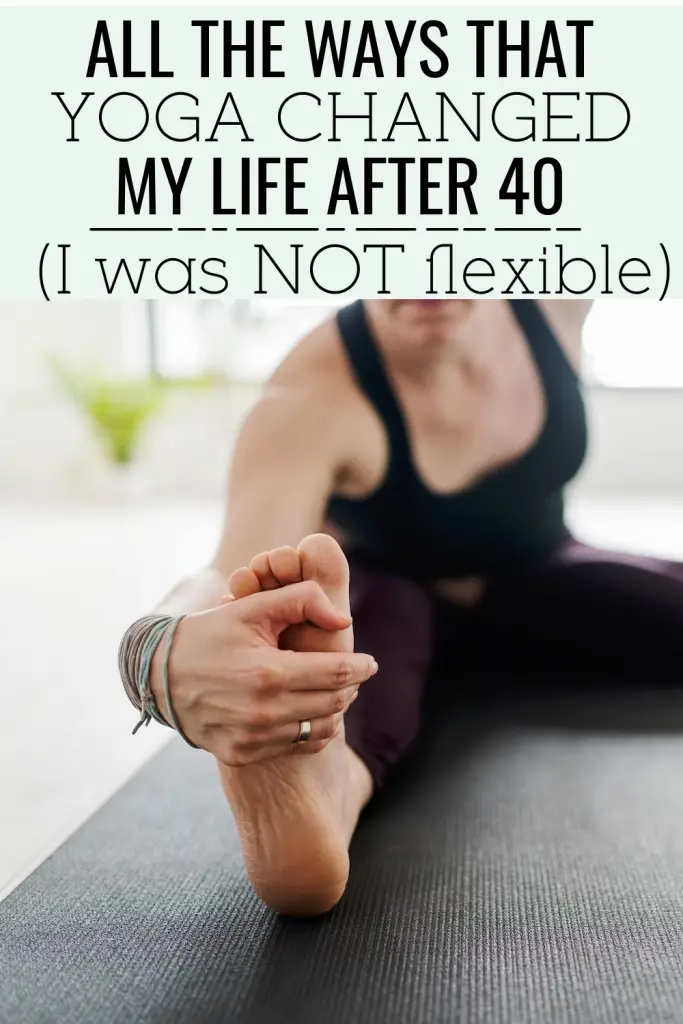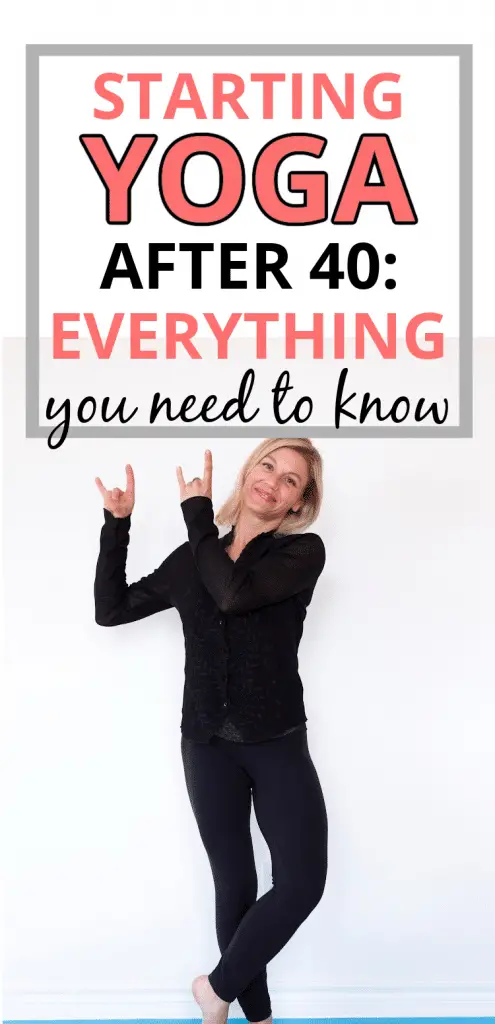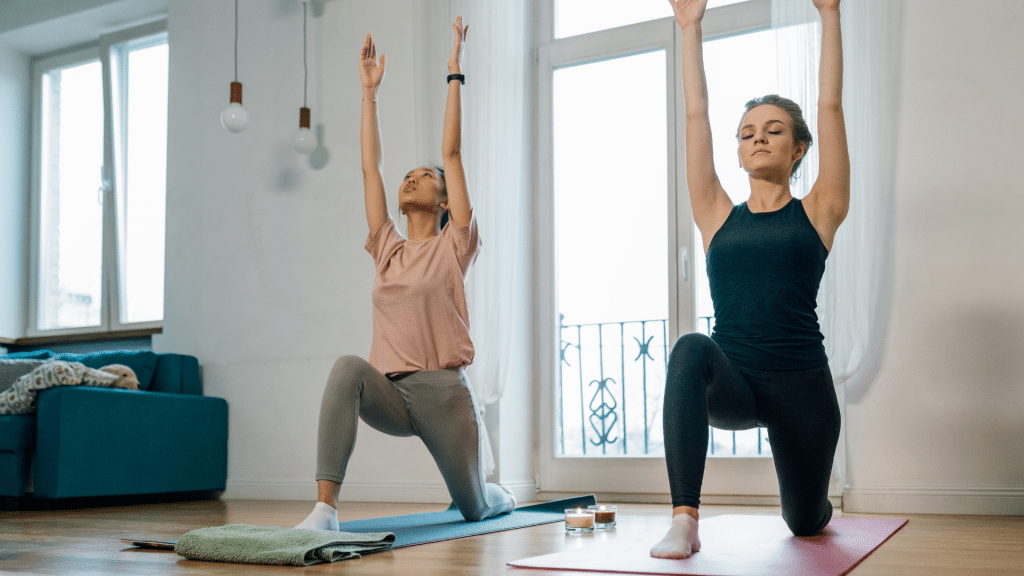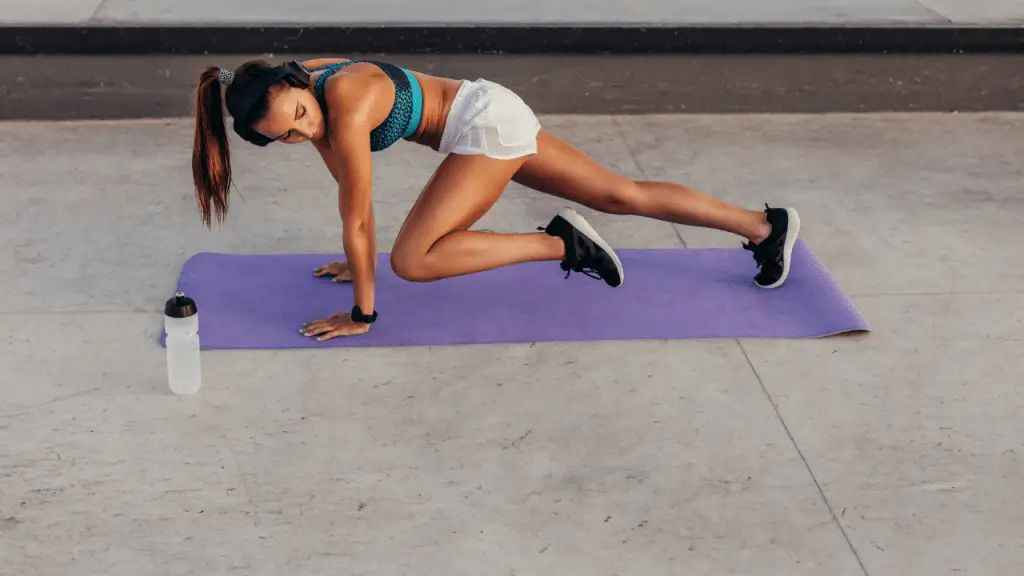Starting yoga at 40 or later will feel different than if you were twenty-something, I know from experience! But you will not regret it!
I looked into learning yoga when I was around 18 years old. Back then, people didn’t have access to all the information online. I got a book, read it, and tried some poses, but I felt it was too complicated (breathing, keeping the right alignment, etc.). In my thirties, I looked into yoga again during my pregnancies, but my training morphed into bodyweight exercises. All that to say, it was not until last year (at age 44) that I took up yoga for real using the streaming site Alo Moves. I loved it so much that I decided to get certified as a yoga teacher (even though I was already a NASM fitness trainer).
Starting Yoga At 40 or Later: Learn the Basics
You may have a few questions when starting yoga at 40 or later. You are searching online for yoga routines to follow or for a local class to join. As it turns out, you see similar practices, sometimes called yoga or pilates. Also, you hear about the different types of yoga but are unsure what they look like.
Difference Between Yoga and Pilates
I decided to write this section because when I told a friend about my yoga practice, she asked me this question, and I had no idea! After researching it, I can tell you the difference isn’t clear-cut. Some articles say that Pilates engages the core more. I disagree. The yoga workouts I have been following engage the core constantly. Then, of course, there is the spiritual aspect of yoga, but many North American teachers teach yoga as a way to move your body without any spiritual references. The line between yoga and pilates has been blurred over time.
After doing workouts labeled as pilates and workouts labeled as yoga, I think yoga requires more mind control. You will recruit your breath as you move through your routine and focus on sending energy through your limbs as you ensure you learn proper alignment for each pose.
Moreover, here are some other key differences:
- Breath: In Pilates, you breathe in through the nose and out through the mouth. In yoga, in through the nose, out through the nose.
- Props: In Pilates, you will use props to add resistance to your workouts. In yoga, props support proper alignment in your poses.
- Experience: Pilates is meant to be a workout that builds strength. Although many types of yoga workouts aim to build strength and endurance, at their core, yoga is more restorative in nature.

Types of Yoga
As we try to understand yoga better, looking at the types of yoga is helpful. There are various approaches to yoga. Here are the most common types of yoga practice:
- Hatha: Hatha yoga tends to be slower and more gentle. You will be holding some basic yoga poses in sequence.
- Ashtanga: With Ashtanga yoga, you will follow specific sequences to challenge your strength, endurance, and flexibility. It will also require more focus as you practice following your breath.
- Vinyasa: Vinyasa yoga is similar to Hatha yoga in that it strings different poses together. However, the pace of Vinyasa yoga is faster, and it emphasizes connecting your breath to your movements. Vinyasa yoga is less intense than Ashtanga yoga as it typically doesn’t challenge your endurance as much.
- Yin: Yin yoga is a much slower type of yoga. Typically, you will hold the poses for 3-5 minutes.
- Restorative: Both yin and restorative yoga require you to stay in poses for a few minutes. However, restorative yoga uses props to keep you comfortable. The purpose of restorative yoga is to calm the central nervous system. Yin yoga may be used to increase your flexibility so that you will experience some discomfort.
There are many other types of yoga and classifications depending on what source you consult. For example, you may hear terms like hot yoga, power yoga, Bikram yoga, and Yin yoga.
Health Benefits of Practicing Yoga
I mentioned that you would not regret starting yoga at 40 or later. I only wish I had started sooner! Yoga transformed my health and fitness! That, even though I had been consistent with HIIT and weightlifting for over a decade! I found yoga an extremely efficient way to work out because most poses will engage your whole body. You will build strength and flexibility and do cardio all at once!
What are the benefits of yoga? You will experience the following benefits and more:
- Improving your posture.
- Increasing your mindfulness.
- Discovering your breath.
- Improving your cardiovascular fitness.
- Increasing your flexibility.
- Strengthening your whole body.
- Improving your endurance.
- Boosting your mood.
- Improving your sleep.
- Decreasing stress.
These are the yoga benefits I could think of off the top of my head because I have experienced them myself—however, some studies document benefits like easing arthritis symptoms and boosting immunity.
Can You Start Yoga In Your 40s?
I think I already made it clear that the answer is yes, but I thought you would benefit from seeing another woman’s yoga transformation after 40. That will also give you an idea of how long it takes for yoga to change your body. I started yoga because I wanted to learn to do the splits and more core strength and definition in my body. Yoga improved my body composition, strength, flexibility, endurance, balance, and mindfulness. After a year of doing yoga almost daily, the difference is visible. Please read 1-Year Yoga Transformation: Before and After Pictures to learn more about my experience.
Throughout my yoga journey in my 40s, I also learned some key considerations, which I hope will help you make the most of your practice.
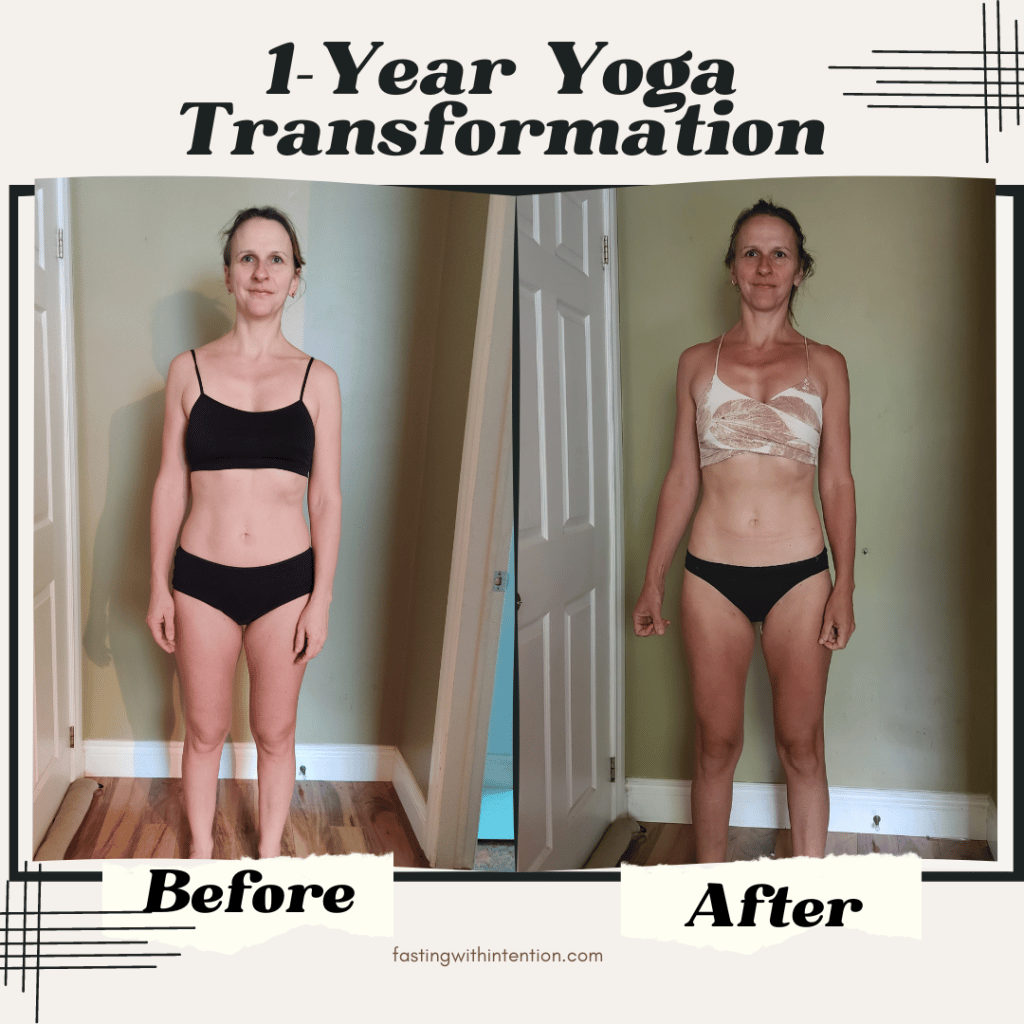
Starting Yoga at 40: How Is It Different?
The two obvious ways that starting yoga at 40 is different are that learning skills later in life can take longer, and your body needs more recovery time as you age. The same applies to any physical activity you may want in your forties. However, yoga is an excellent practice you can learn later in life because many forms are gentle, and it’s easy to adapt to your fitness level.
Special Considerations When Starting Yoga at 40
Let’s discuss some practical considerations to ensure you start yoga safely and effectively.
Keep It Interesting
Hey, listen! Forty years old is not that old! You don’t need to treat yourself like an old lady. It’s ok to push your limits! That’s one of the main ways I keep my yoga practice interesting. I like to challenge myself to learn new skills and new poses. One fun thing about yoga is that you can always advance and improve. You can see your progress, and it can be extremely motivating! No reason to settle for a boring workout routine to check exercise off your list. Instead, watch your favorite yoga instructors and pick more advanced poses they teach to include in your daily drills.
Listen to Your Body
Depending on your personality, you may find it more challenging to push yourself or pace yourself. You want to be somewhere in the middle. Depending on the day, you may need to adjust your practice to push or pace yourself. That’s where learning to listen to your body is essential. Pay attention to signs like feeling tighter, less strong, or less persistent. Honor these cues from our bodies to pace ourselves for a few days. They will likely disappear, and you can pick up where you left off. If the situation doesn’t resolve independently, then push yourself a bit. Push through the discomfort and see what happens. You may find that it was mostly a mental block. It truly depends!
Pick Your Type of Yoga
The best tip I can give you to pick your type of yoga is to try different ones. Check out various teachers and their classes (whether online or in person). You will discover which ones you enjoy most and keep practicing your favorites until you feel ready to advance to the next level. Yoga for a 40-year-old woman can be anything you want it to be!
Set a Goal
What I love about my yoga practice is that there is always a new goal to pick. I started yoga with wanting to achieve the splits. Then, I tried to learn the King Pigeon Pose and the Wheel Pose. I decided to learn to headstand, handstand, and the Crow Pose. Then, I tried to learn some cool transitions. Working towards a goal can be invigorating.
Sample Yoga Routine Over 40 (Yoga for Middle-Aged Beginners)
This post would not be complete without a sample yoga routine. I would consider myself at an intermediate fitness level, but I have been doing yoga for a relatively short time (compared to many other yoga instructors). That’s why I think you will enjoy this sample yoga routine. It is not a gentle routine designed for mindfulness and meditation. Instead, I created it to take advantage of bodyweight exercises to increase your strength and tone your body. It will make the most of your time by challenging your endurance while allowing beginner modifications. That is how I like to practice yoga!
How Many Days a Week Should Beginners Do Yoga?
I think the best approach to doing yoga for beginners is more frequent but shorter sessions. I recommend beginners aim for 20-30 minutes of yoga six days a week. The same tip applies when starting yoga at 40 or later.
You will find some excellent yoga routines on this site. For example, try Yoga for Energy: 10 Poses to Increase Your Energy Fast. You may also want to check out Alo Moves, my favorite yoga streaming site.
If you need help staying consistent with your yoga practice, I recommend you join my 5-Day Yoga Habit Challenge. You will receive short daily yoga routines and practical tips to instill lasting habits so you can make impactful changes in your life.
How to Save Yourself Lots of Time and Frustration When Starting Yoga at 40
Starting yoga at 40 or later can be frustrating. You may find that finding the right balance between challenging and accessible is a guessing game that costs you lots of time and energy. Most yoga instructors no longer remember what it’s like to be a beginner (particularly a beginner over 40). It’s almost impossible to find online routines that build gradually and strategically so that you can get from I-am-so-stiff-I can-barely-touch-my-toes to wow-look-at-me-I-have-abs-and-I-can-do-the-splits.
Instead, you may have to stumble around in the dark online as you try to find appropriate routines for your level AND it will yield results. You either get frustrated because you can’t follow along or bored because it’s too easy. Some days, you will feel strong and fierce; some days, you struggle to move through simple transitions. That’s perfectly natural! I sometimes tell myself: Wow, this would be a lot easier if I was twenty (particularly when moving from backends to forward fold, for example), but you know what? I am doing it, and that counts.
Join my 5-Day Yoga Habit Challenge for guidance, or check out my 3-Month Mind/Body Yoga Transformation Coaching Solution. My Coaching Program is the ultimate way to save yourself time and frustration when starting yoga at 40 or later.
